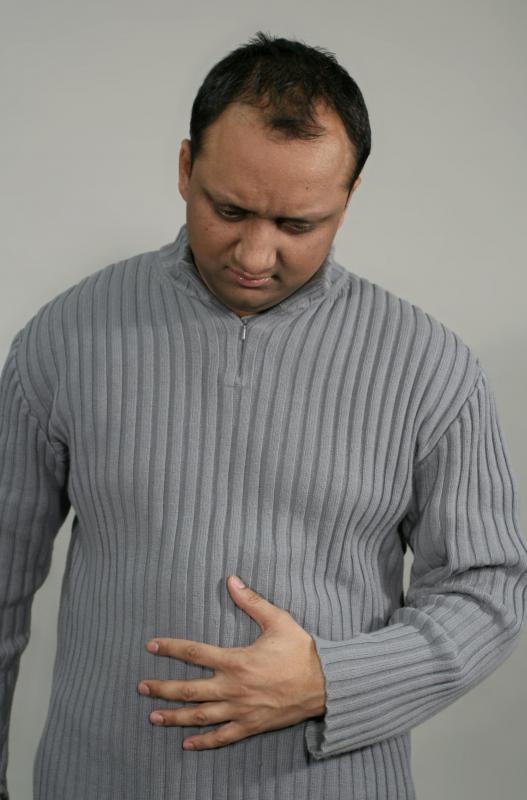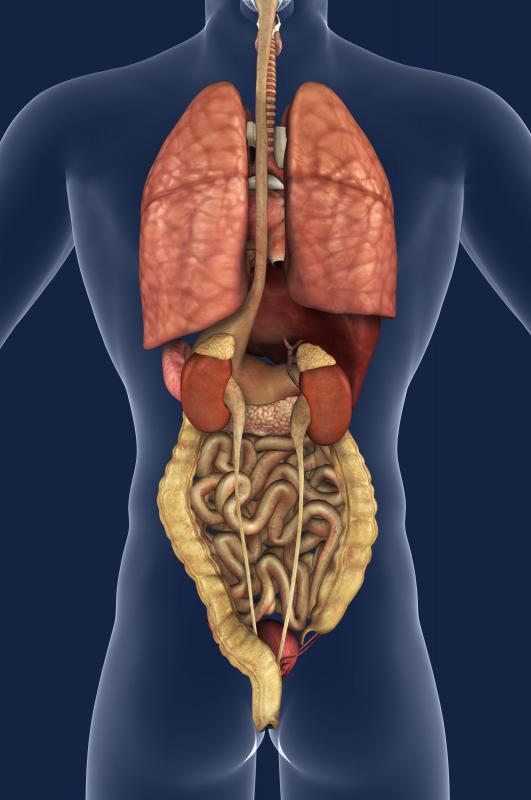At WiseGEEK, we're committed to delivering accurate, trustworthy information. Our expert-authored content is rigorously fact-checked and sourced from credible authorities. Discover how we uphold the highest standards in providing you with reliable knowledge.
What is Acalculous Cholecystitis?
Acalculous cholecystitis is a form of gallbladder inflammation that occurs in the absence of gallstones. The term acalculous is utilized to qualify that the cholecystitis is not in any way associated with the presence of gallstones. Acute acalculous cholecystitis is generally diagnosed in individuals with an existing chronic condition, such as diabetes, that induces swelling and inflammation of the gallbladder. Treatment for this painful condition is entirely dependent on symptom presentation and the overall health of the individual.
Usually, gallbladder inflammation is associated with the presence of gallstones that block bile ducts and prevent the acidic fluid from passing into the small intestine. Cholecystitis occurs when inflammation and swelling alone prevents the natural flow of bile through the gallbladder into the upper digestive tract. Rare in presentation, chronic acalculous cholecystitis can contribute to adverse physiological changes within the gallbladder, including atrophy and tissue hardening. As the gallbladder shrinks and thickens it loses its elasticity, compromising its ability to contract and secrete bile. In the absence of proper function, the acidic composition of the accumulating bile promotes tissue inflammation.

A preliminary diagnosis of cholecystitis, or gallbladder inflammation, is generally made during a physical exam in which a physician performs a palpatory evaluation of the abdominal area to check for signs of distention and tenderness. Imaging tests, including an ultrasound, are generally ordered to assess the condition and size of the gallbladder and functionality of the upper gastrointestinal (GI) tract. Additional testing may involve the administration of a blood panel and oral cholecystogram, which is utilized to confirm or discount the presence of gallstones.

There are a variety of signs and symptoms associated with the bile accumulation that occurs with cholecystitis. After eating, symptomatic individuals may develop moderate to severe right-sided, abdominal pain that persists for several hours. In some cases, abdominal discomfort may progressively worsen and impair one’s ability to breathe deeply. Additional signs of acalculous cholecystitis may include fever, vomiting and nausea. It is also possible for some individuals to remain asymptomatic, meaning they experience no symptoms at all, or only experience mild abdominal discomfort.

Treatment for acalculous cholecystitis is generally dependent on the severity of one’s symptoms and his or her health. Individuals with mild symptoms may experience relief with the administration of antibiotic and analgesic medications. More severe presentations may necessitate hospitalization and the surgical removal of the gallbladder, a procedure known as cholecystectomy. Often performed laparoscopically, a cholecystectomy does carry some risk for complications, including excessive bleeding and infection.
AS FEATURED ON:
AS FEATURED ON:

















Discussion Comments
@anon98609323: I've had symptoms for about two years and recently had a HIDA scan in which my gallbladder didn't fill at all, despite clean ultrasounds and CT scans. My gastroenterologist and surgeon tell me this indicates acalculous cholecystitis, which is usually seen in an emergency setting.
In my case, I've had no fever, no pain at all, just a lot of nausea, fullness, no appetite, and gastritis-like symptoms for 2 years. I'm not convinced having it removed will help anything as I'm such an odd case, but they tell me it's a ticking time bomb. Tough decision.
Does anyone know of any cases of (asymptomatic) Acalculous Cholecystitis occurring over several years?
@sunnySkys - My aunt had her gallbladder taken out, and even though she does have some digestive issues, she feels much better than she did. One thing that has really helped her is taking a digestive enzyme supplement. If you are still in contact with your associate from training, you might suggest that to him!
It's interesting that acalculous cholecystitis can cause unpleasant digestive symptoms, because so can having your gallbladder removed! I did my training for my last job with a young guy who had had his gallbladder taken out in the last year, and the was sick a few times during the training.
Apparently after you have your gallbladder removed, certain foods can really aggravate your digestive system. However, it sounds like the symptoms from that aren't constant like the symptoms of a gallbladder condition. I guess having your gallbladder out is the better option if you're sick, but it still sounds unpleasant!
Post your comments